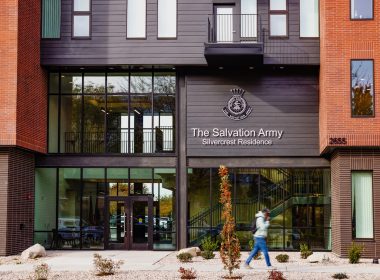Corps turn to Tithe.ly as pandemic shelves collection baskets.
By Jared McKiernan –
With traditional Sunday worship services on pause due to COVID-19, tithing numbers have taken a nosedive across the U.S.
A survey by the National Association of Evangelicals of over 1,000 churches showed nearly two-thirds of churches have seen a decline in Sunday giving since mid-March. In a Barna survey of 434 pastors through the end of March, 79 percent said giving was down, with 47 percent reporting it’s down “significantly.”
It’s a trend playing out in The Salvation Army Western Territory, too. According to data collected by the West, total giving is down about 28 percent since February, the last full calendar month before stay-at-home orders were put in place.
While many churchgoers now mail checks in or drop them off in person, those options don’t exist for everyone, and it’s caused a significant setback for many corps.
“Most of our folks give cash [so we’ve seen a] significant drop,” said Santa Barbara (California) Corps Officer Major Jessyca Carr. “We have some pretty financially insecure folks who manage to give $5 here, $20 there, but a lot of them don’t have bank accounts.”
There is, however, reason for optimism: the pandemic has sparked a widespread surge in online donations through Tithe.ly, an online giving app that charges a small fee per donation. Since making Tithe.ly available to the Western Territory in April 2018, The Salvation Army has seen gradual adoption of the platform in many of its corps.
In February, Tithe.ly donations accounted for about 9 percent of church giving in the West. By the end of April, that number increased to 31.5 percent. The weekly average of all Tithe.ly donations in the territory similarly climbed from about $12,000 in February to nearly $30,000 in April—a 150 percent spike.
Major Gwyn Jones, Concord (California) Corps Officer, said even before the pandemic hit, many people in his corps were using Tithe.ly. That, he said, has helped his corps not only weather the crisis, but actually increase its total giving since mid-March.
“I’ve been able to remind people to give through our weekly Facebook Live service,” he said. “We’ve chatted with our church leaders about keeping the Facebook Live service even after things go back to whatever normal will be.”
Yet, online giving hasn’t been equally embraced by each community. Oftimes, its adoption is heavily influenced by the makeup of a given congregation. Case in point: the Monterey Peninsula (California) Corps.
Assistant Corps Officer Lt. David Vargas said he’s the only one in his corps who gives online. Everyone else still prefers to mail in their checks or drop them off at the office. All that to say, the corps’ total giving has remained steady during the pandemic.
“Our congregation is older and prefers to write a check [instead of] potentially give out their information,” Vargas said. “They don’t trust the internet, nor do they like the fee that they incur for giving.”
One thing’s for certain: without online donations to help defray dips in overall giving, the pandemic could pose a much more stubborn challenge for many corps.
Tim Schaal, the West’s IT Director, noted it’s difficult to predict if the Tithe.ly trend will persist once traditional worship services pick back up. Still, it’s likely online donations will dip from where they are now, but not necessarily back to pre-COVID-19 levels.
As Schaal said, “More individuals have now discovered how easy it is to give via Tithe.ly.”











